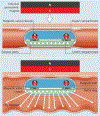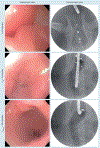Controlled colonic insufflation by a remotely triggered capsule for improved mucosal visualization
- PMID: 24845802
- PMCID: PMC7047728
- DOI: 10.1055/s-0034-1365497
Controlled colonic insufflation by a remotely triggered capsule for improved mucosal visualization
Abstract
Background and study aims: Capsule endoscopy is an attractive alternative to colorectal cancer screening by conventional colonoscopy, but is currently limited by compromised mucosal visibility because of the lack of safe, controlled colonic insufflation. We have therefore developed a novel system of untethered, wireless-controlled carbon dioxide (CO2) insufflation for use in colonic capsule endoscopy, which this study aims to assess in vivo.
Material and methods: This observational, nonsurvival, in vivo study used five Yorkshire-Landrace cross swine. A novel insufflation capsule was placed in the porcine colons, and we recorded volume of insufflation, time, force, visualization, and a pathologic assessment of the colon.
Results: The mean (standard deviation [SD]) diameter of insufflation was 32.1 (3.9) mm. The volume of CO2 produced successfully allowed complete endoscopic visualization of the mucosa and safe proximal passage of the endoscope. Pathologic examination demonstrated no evidence of trauma caused by the capsule.
Conclusions: These results demonstrate the feasibility of a novel method of controlled colonic insufflation via an untethered capsule in vivo. This technological innovation addresses a critical need in colon capsule endoscopy.
© Georg Thieme Verlag KG Stuttgart · New York.
Conflict of interest statement
Figures



Similar articles
-
Maneuverability and safety of a magnetic-controlled capsule endoscopy system to examine the human colon under real-time monitoring by colonoscopy: a pilot study (with video).Gastrointest Endosc. 2017 Feb;85(2):438-443. doi: 10.1016/j.gie.2016.07.053. Epub 2016 Jul 29. Gastrointest Endosc. 2017. PMID: 27480288
-
Wireless insufflation of the gastrointestinal tract.IEEE Trans Biomed Eng. 2013 May;60(5):1225-33. doi: 10.1109/TBME.2012.2230631. Epub 2012 Nov 29. IEEE Trans Biomed Eng. 2013. PMID: 23212312 Free PMC article.
-
Colon capsule endoscopy compared with conventional colonoscopy for the detection of colorectal neoplasms.Expert Rev Med Devices. 2011 Mar;8(2):257-61. doi: 10.1586/erd.10.84. Expert Rev Med Devices. 2011. PMID: 21381914
-
Applications of Colon Capsule Endoscopy.Curr Gastroenterol Rep. 2018 Apr 12;20(5):22. doi: 10.1007/s11894-018-0628-7. Curr Gastroenterol Rep. 2018. PMID: 29644509 Review.
-
The colon - the latest terrain for capsule endoscopy.Dig Liver Dis. 2007 Oct;39(10):895-9. doi: 10.1016/j.dld.2007.07.050. Epub 2007 Aug 27. Dig Liver Dis. 2007. PMID: 17720639 Review.
Cited by
-
Wireless endoscopy in 2020: Will it still be a capsule?World J Gastroenterol. 2015 May 7;21(17):5119-30. doi: 10.3748/wjg.v21.i17.5119. World J Gastroenterol. 2015. PMID: 25954085 Free PMC article. Review.
-
Capsule Endoscopy: Pitfalls and Approaches to Overcome.Diagnostics (Basel). 2021 Sep 25;11(10):1765. doi: 10.3390/diagnostics11101765. Diagnostics (Basel). 2021. PMID: 34679463 Free PMC article. Review.
-
Video capsule endoscopy: perspectives of a revolutionary technique.World J Gastroenterol. 2014 Dec 14;20(46):17330-44. doi: 10.3748/wjg.v20.i46.17330. World J Gastroenterol. 2014. PMID: 25516644 Free PMC article. Review.
-
Capsule endoscopy: The road ahead.World J Gastroenterol. 2016 Jan 7;22(1):369-78. doi: 10.3748/wjg.v22.i1.369. World J Gastroenterol. 2016. PMID: 26755883 Free PMC article. Review.
-
Advances in Capsule Endoscopy.Gastroenterol Hepatol (N Y). 2015 Sep;11(9):612-7. Gastroenterol Hepatol (N Y). 2015. PMID: 27482183 Free PMC article.
References
-
- U.S. Cancer Statistics Working Group. United States Cancer Statistics: 1999–2009 Incidence and Mortality Web-based Report. Atlanta: U.S. Department of Health and Human Services, Centers for Disease Control and Prevention and National Cancer Institute; 2013: Available at: www.cdc.gov/uscs Accessed: 21 March 2013
-
- Selby JV, Friedman GD, Quesenberry CP et al. A case-control study of screening sigmoidoscopy and mortality from colorectal cancer. N Engl J Med 1992; 326: 653–657 - PubMed
-
- Hardcastle JD, Chamberlain JO, Robinson MH et al. Randomised controlled trial of faecal-occult blood screening for colorectal cancer. Lancet 1996; 348: 1472–1477 - PubMed
-
- Kronborg O, Fenger C, Olsen J et al. Randomised study of screening for colorectal cancer with faecal occult blood test. Lancet 1996; 348: 1467–1471 - PubMed
-
- Winawer SJ, Fletcher RH, Miller L et al. Colorectal cancer screening: clinical guidelines and rationale. Gastroenterology 1997; 112: 594–642 - PubMed
Publication types
MeSH terms
Substances
Grants and funding
LinkOut - more resources
Full Text Sources
Other Literature Sources
Medical

